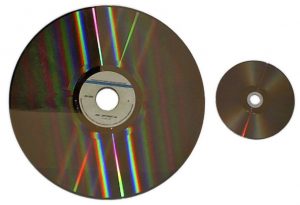History (1972): Optical Laser Disc Player Demonstrated
MCA and Philips develop laser technology for distributing consumer movies.
This is a Press Release edited by StorageNewsletter.com on March 20, 2018 at 2:47 pmThis article comes from the Computer History Museum.
1972: Optical Laser Disc Player is demonstrated
MCA and Philips develop laser technology for distributing consumer movies.
Laser disc (30cm diameter) vs DVD

(Kevin586, Creative Commons BY-SA 2.5)
Victorian music-box discs and phonograph records, played significant roles in enabling the music industry but, until the introduction of the laser disc in the late 1970’s, no non-magnetic disk exerted a significant impact on computer storage. Note that ‘disc’ vs. ‘disk’ has been used interchangeably by various organizations in the storage industry.
Pioneering optical disc recording patents include filings by David Paul Gregg for transparent media (1958); James Russell for a photographic process (1966), and Jon Clemons (1971) for RCA’s VideoDisk CED (Capacitance Electronic Disc) technology. In 1969, Dutch physicists Klaas Compaan and Piet Kramer at Phillips developed an analog system using a laser diode and reflective optical techniques that yielded a December 1972 joint public demonstration of a Phillips Video Long Play (VLP) laser player with discs produced by MCA (Music Corporation of America).
Accompanied by ‘Jaws’, the first MCA movie on disc, in 1978 Philips introduced the Magnavox VH-8000 consumer laser disc player in the U.S for $749. Pioneer of Japan trademarked the name LaserDisc and followed with the VP 1000 in 1979.
For training and educational applications, Digital Equipment Corporation (DEC) developed an Interactive Video Instructional System (IVIS) interface and in 1979 a Chicago Museum of Science and Industry exhibit allowed visitors to search the Chicago Tribune newspaper.
Laser discs offered superior image and sound compared to earlier Betamax and VHS video tape formats, but due to high price and lack of recording ability, they were not successful in the market. However the essential elements of laser disc technology evolved from analog to digital technology through several generations into the popular CD-ROM, CD-R and DVD systems.













 Subscribe to our free daily newsletter
Subscribe to our free daily newsletter

